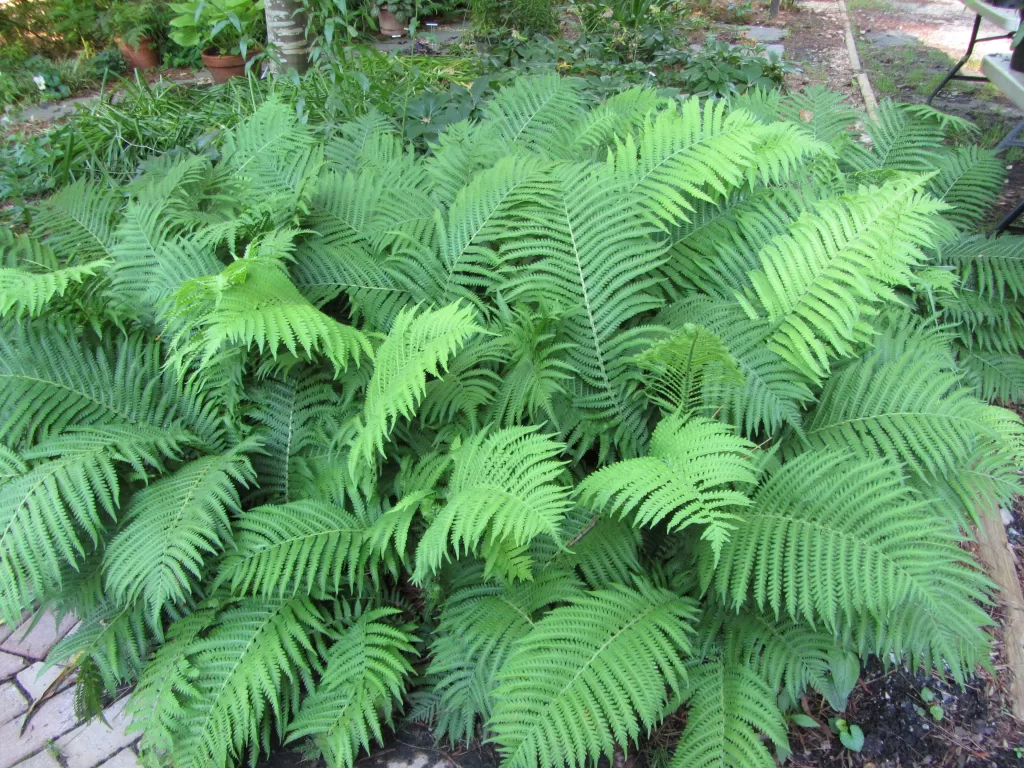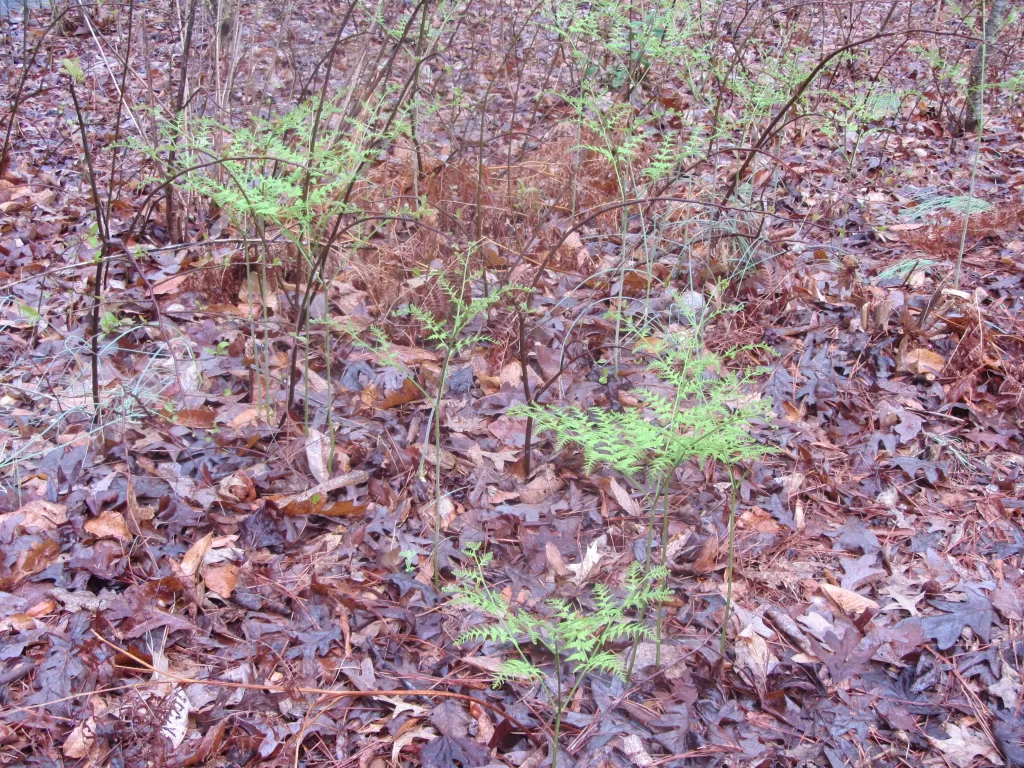Can I Nibble the Fiddleheads?
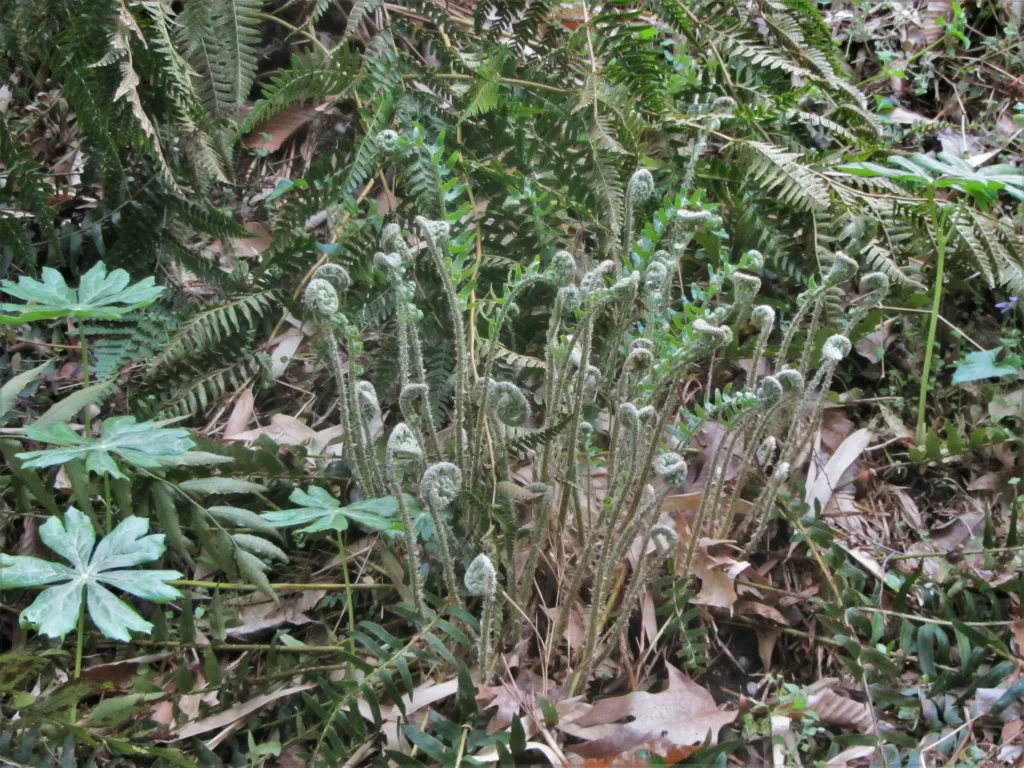
Fiddleheads emerge on Christmas fern, Polystichum acrostichoides, in March. Notice the still evergreen fronds around this clump which help to identify the species. This fern is NOT edible.
Fiddleheads
Perfect little green, tightly curled fiddleheads will soon push through the damp earth and begin to unfurl themselves into delicate fern fronds. They might look tasty, and you might wonder whether you can pluck one to nibble as you hike through the woods.
Coastal Virginia hosts almost 30 native fern species, and fern-loving gardeners plant dozens more introduced species. Quite honestly, unless you are a Pteridophile, or fern-o-phile, they probably look much the same. You will find fiddleheads in various shades of green, or perhaps bronze. Some may be fuzzy or furry as they emerge. Their mature shapes show themselves as they uncurl. Please resist the temptation to harvest any of them as a crunchy snack.
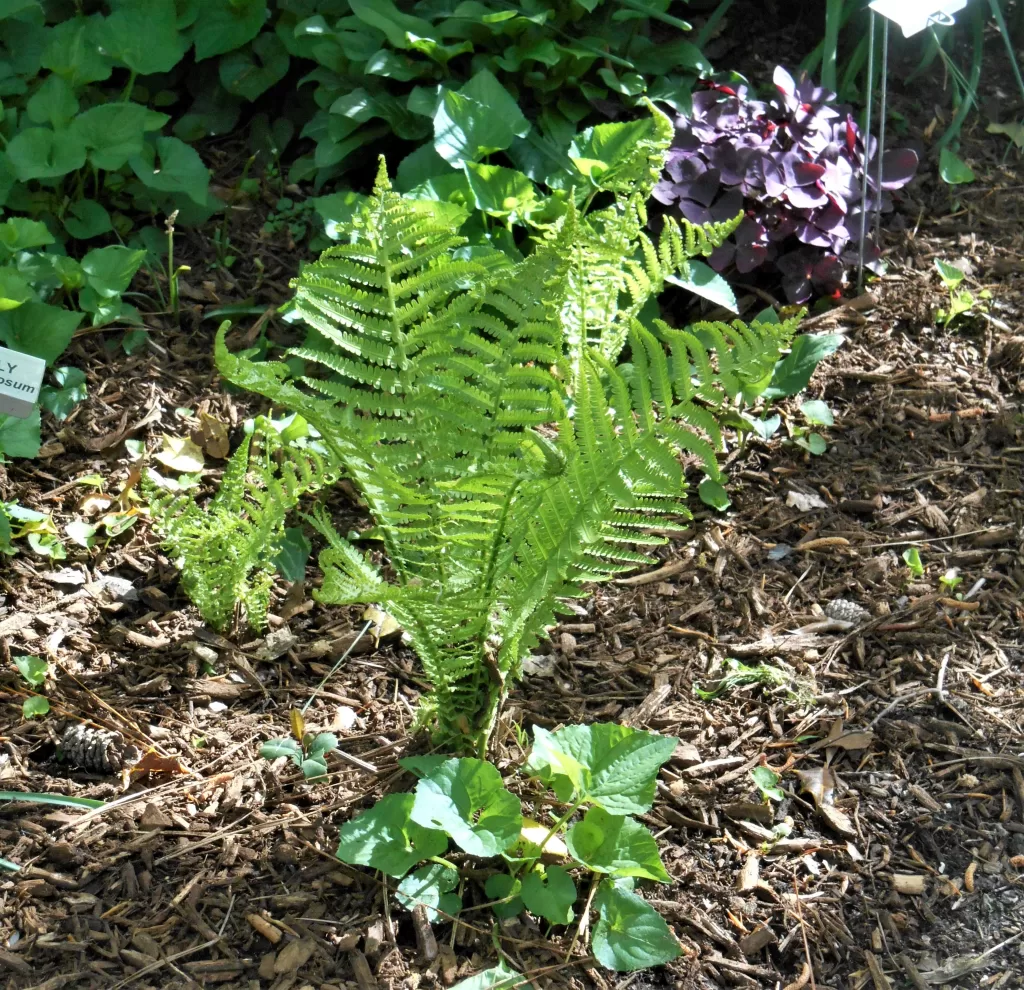
Ostrich ferns, the only truly edible ferns in our area, emerge in tight, round clumps and spread by underground rhizomes. These are already too developed to harvest to eat in mid-April. Watch for the tightly curled fiddleheads to emerge in March. The Williamsburg Botanical Garden 2018.
Edible Ferns
There is only a single type of fern growing wild in our area that is safe to eat, and it should first be washed, dressed, and blanched. The ostrich fern, Onoclea struthiopteris (formerly Matteucia struthiopteris) is tasty and safe to eat. It contains vitamins A and C. While native to Eastern North America, botanists don’t consider ostrich fern indigenous to either James City or York Counties. Other types of ferns may be recommended as edible in some books or websites. The bracken fern, Pteridium aquilinum, is even sold, dried or fresh, in some outlets for use in cooking. But the ostrich fern is the only fern you will find locally that you can enjoy eating without worry.
Still, make sure that you correctly identify the ostrich fern’s fiddleheads before harvesting them. There are specific traits to look for, and you should always confirm the identification of any wild, foraged food with multiple indicators before eating it. One visual clue isn’t enough until you are an expert, and experts know to look for all the hallmarks of the species to make a firm identification before popping a wild plant into their mouth.
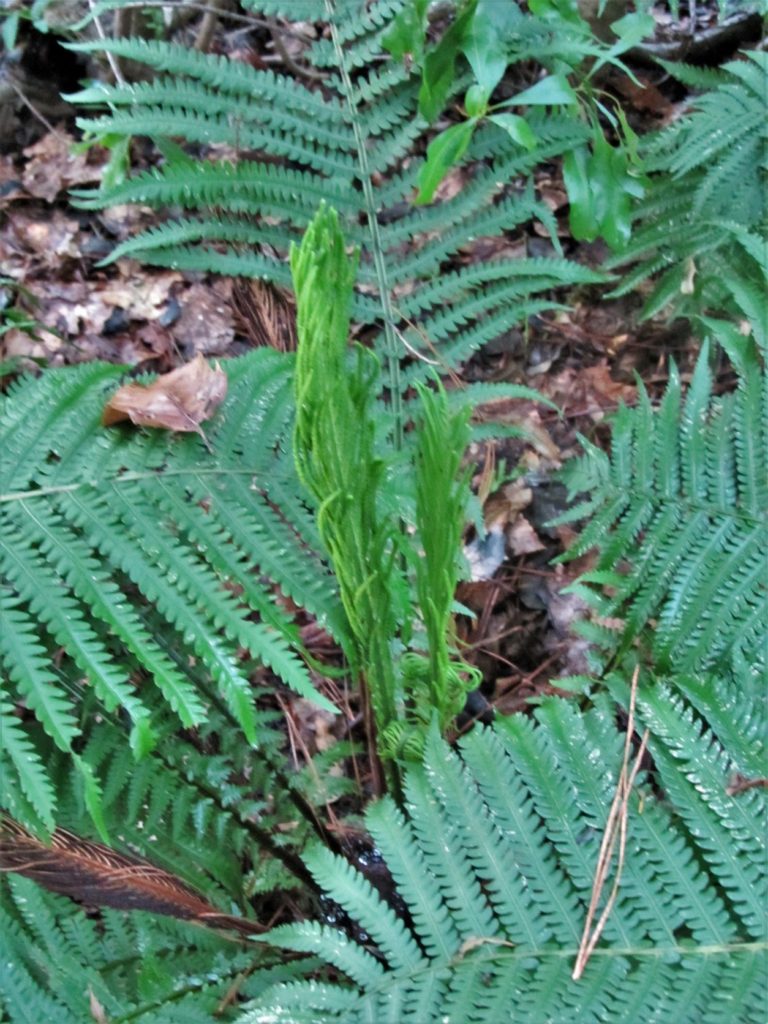
Fertile fronds emerge green on the Ostrich fern and turn brown as the season progresses. The stiff, fertile frond, which contains all of the spores for the plant’s reproduction, resembles an upright feather.
How to Identify Edible Ostrich Ferns
Ostrich ferns have two different types of fronds. The fertile, spore bearing fronds stand all winter even as the soft, green, infertile fronds fade away after autumn’s first hard frost. The spring fiddleheads are replacing last season’s deciduous green fronds even as the standing fertile fronds may still be releasing spores for the next generation. So, look for fiddleheads emerging in a small clump around standing, fertile fronds that appear like stiff, brown feathers about 18”-24” tall.
Other fern species, sometimes mistaken for ostrich ferns, won’t have fertile fronds still standing. However, a few other native species, such as the cinnamon fern, Osmundastrum cinnamomeum, and sensitive fern, Onoclea sensibilis, also have overwintering fertile fronds. Take a closer look at the standing fertile fronds and fiddleheads before cutting them. Cinnamon fern and sensitive fern aren’t poisonous, but aren’t very good to eat, either. Cinnamon fern has been linked to upset stomach and other troubling gastric symptoms. These two ferns are sometimes mistaken for ostrich fern in early spring because of their fertile fronds, though their fertile fronds each have a distinct shape and texture which is different from the feather-like shape of ostrich fern.
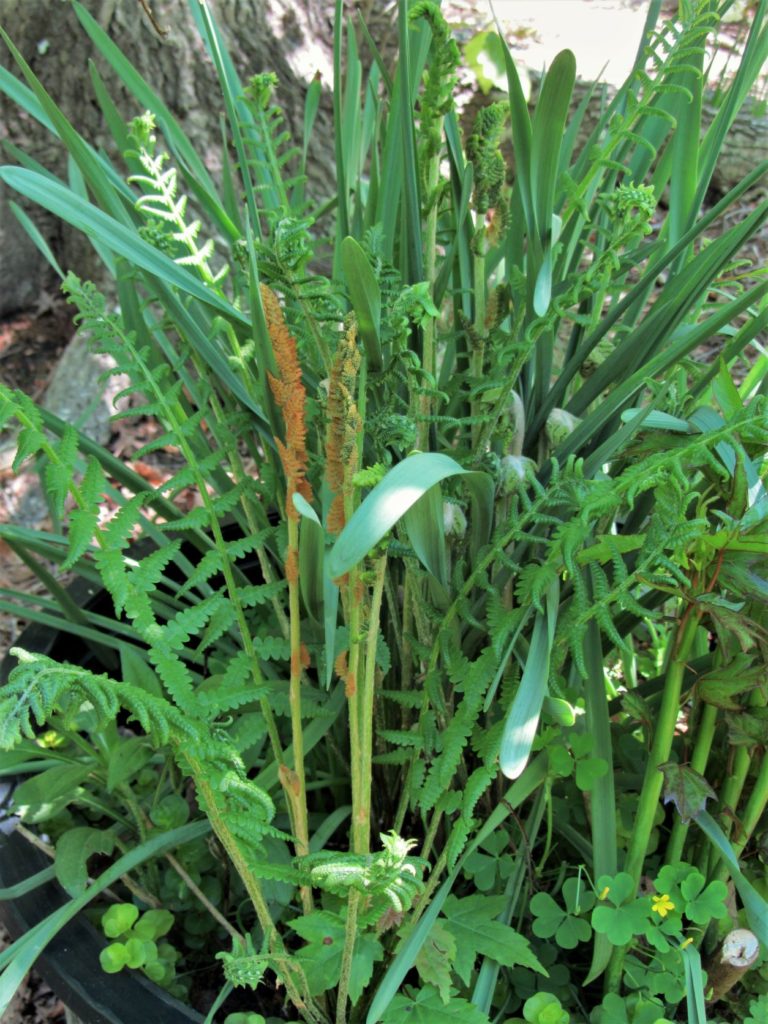
The cinnamon fern also has fertile fronds which are already brown with spores as they emerge in the spring. Cinnamon fern is NOT edible, despite its name.
Ostrich fern has a concave, or “U” shaped stipe or stem. When you harvest your first fiddlehead, by cutting it off near the base with a sharp knife or shears, you should be able to stick your thumbnail into a little groove on the front side of the stem under the fiddlehead. If there is no groove, you have a different type of fern, not an ostrich fern fiddlehead.
Finally, notice whether there is a brown, papery fuzz covering the plump, light green fiddlehead. If the fuzzy covering is silver, the fiddleheads are likely cinnamon fern. Several different types of ferns have this fuzzy covering before they unfurl, so use this as a third indicator along with the light green fiddlehead, which will also be plump since Ostrich fern fronds grow quite large.

Cinnamon fern fiddleheads are covered in a light, silvery fuzz in the spring and its fiddlehead is broader than an ostrich fern’s. Their fertile fronds have been cut away. Do Not eat these because they will likely give you an upset stomach.
Fiddlehead Harvest and Preparation
If you are sure of your identification, then harvest only a few fiddleheads from each round clump. If there are five emerging fiddleheads, take no more than two, so the plant will still have fronds left standing this year, and will recover from your harvest. Ostrich fern forms colonies, so there will likely be several additional clumps nearby with more fiddleheads to harvest. Harvest the fiddleheads when they have first fully emerged from the soil and until they are perhaps 10 to 12 inches tall. But make sure that there is still a tightly curled fiddlehead at the top of each stem you cut. Cut near the base of the stem, or stipe, because the stem, much like fresh asparagus, is also good to eat. This fern is no longer considered edible once the frond has opened.
Collect your harvested fiddle heads in a bag that you can close up to slow their wilting. Once home, first place your harvest in a colander and spray them to remove visible soil, then soak them in cool water to clean. Repeat the rinse and soak, gently rubbing off the furry coating with your fingers, until the soaking water remains clear and clean. Boil a pot of salted water and have a bowl of cool water waiting to quickly stop the cooking.
Cooking With Fiddleheads
When the fiddleheads are all cleaned, drop them into the boiling water and time their cooking for about two minutes to blanch them. Scoop them out of the boiling water and drop them into the cool water. Now they are ready to eat. The University of Maine Cooperative Extension experts recommend boiling the fiddleheads for about 15 minutes before eating them as a vegetable. Always blanch fiddleheads before freezing, pickling, or using them in a recipe. There have been instances of people developing ‘food poisoning’ type intestinal symptoms after eating raw, or improperly prepared fiddleheads, so follow these steps carefully.
Enjoy the fiddle heads as crudites with your favorite dip, on a salad, or add them to a stir fry. Batter them in tempura batter and fry them crisp. You may pickle them or add them to a light, brothy soup. Lay fiddleheads in a pretty pattern on top of a pancake, or rice cake, or roll them up into your sushi. You might also enjoy them in a cheesy omelet or on a sandwich.
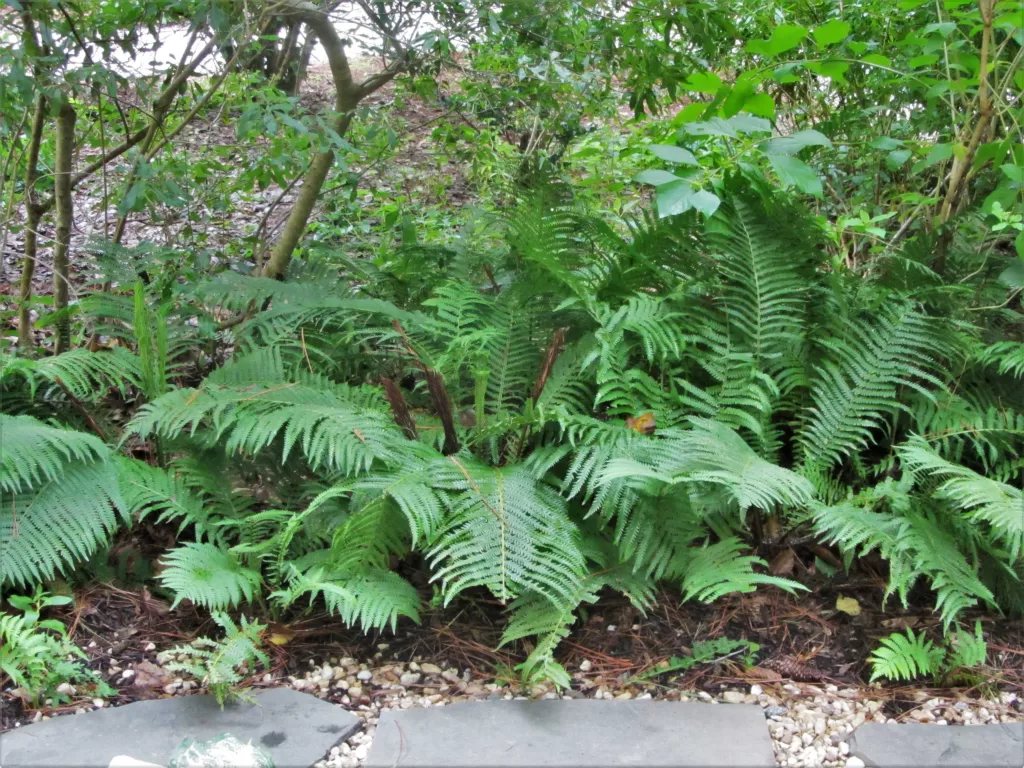
Ostrich ferns at the Williamsburg Botanical Garden and Freedom Park Arboretum in August 2021. The green, sterile fronds will die back after the frost leaving the fertile fronds standing through the winter.
Growing Your Own Fiddlehead Harvest
You may want to grow your own ostrich fern fiddleheads once you taste them. You will need a damp, shady place to grow them, and enough self-restraint to harvest only a few of them each year. Ostrich ferns will grow on all types of soil, including clay, but a loose, fertile loam with plenty of organic matter (compost or chopped up leaves) mixed in will yield the best plants.
These ferns want consistent moisture, so plan to water them during summer dry spells for the first year or two as they establish. They will thrive if you can plant them in a low spot where water drains when it rains. Ostrich ferns send out horizontal stems, called rhizomes, to root and form new clumps. Each of those rooted clumps can be dug up and transplanted to spread the ostrich ferns around in additional shady areas in your yard or in nearby woods. If you don’t have a good place to plant them in your yard, consider growing these ferns in a large container kept in the shade.
Ostrich ferns are one of our prettiest native ferns and thrive in damp, shady spots in Zones 3-8. They have very lacy, finely divided fronds that grow to around 3’ to 5’ tall in clumps that may stretch 2’ to 4’ across. They will grow in deep shade, partial or dappled shade under trees, but don’t plant in full sun. The more consistent the moisture, the more sunlight these ferns can handle, and the more lushly your plants will grow.
Other ‘Edible’ Ferns
Ostrich fern fiddleheads are the only fern species currently considered safe to eat by experts. However, bracken fern is indigenous to James City and York counties and grows well throughout Virginia. It spreads quickly on its rhizomes and may be considered aggressive in favorable conditions. It can be recognized by its very large fronds which emerge individually instead of in clumps.
Not only does bracken fern inhibit thiamine uptake when eaten in large quantities, it can cause neurological symptoms and has been linked to several forms of cancer in various mammals. Horses and cows that eat bracken fern suffer symptoms and may be poisoned from grazing on it, and the toxic components of bracken fern will be found in the milk of cows who have eaten it.
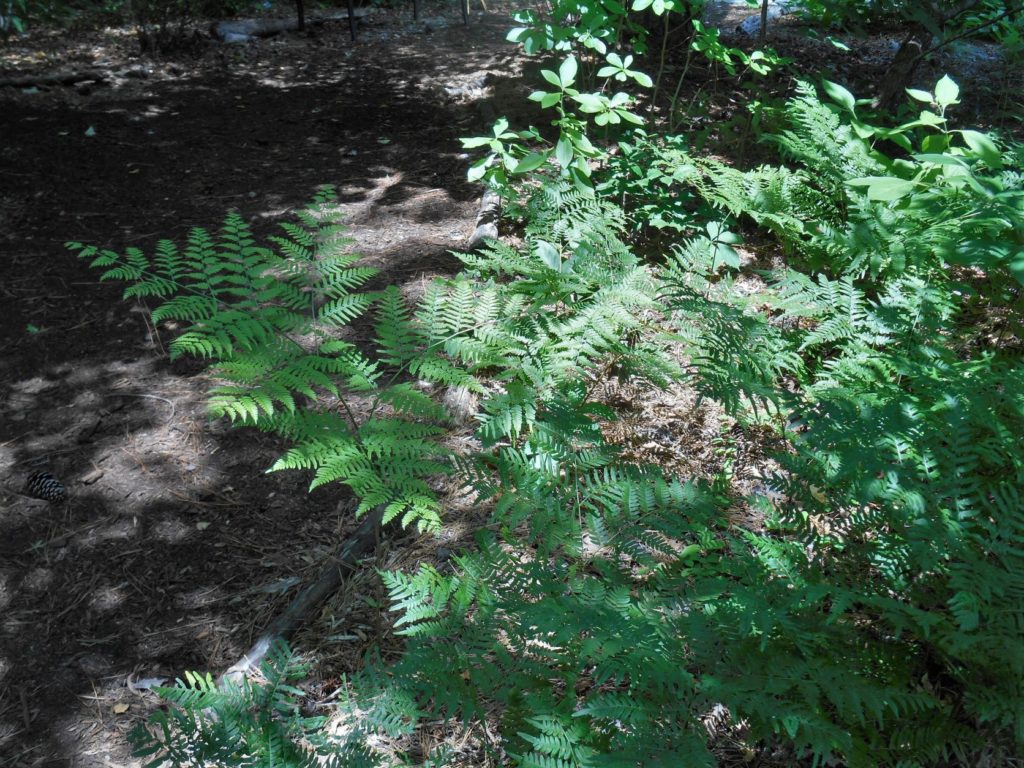
Bracken ferns naturalize along a path at the WBG-FPA. This fern grows in many countries of the Northern Hemisphere and is considered invasive in some. While its fiddleheads and rhizomes were eaten by Native Americans and it is considered a delicacy in China and Japan, it may still cause sickness, particularly if eaten raw.
While it is considered a delicacy in Japan, China, and other countries, it appears that Native Americans throughout North America also ate it. Recently discovered links to several types of cancers caused by consumption of bracken fern are troubling. The offending substance in bracken fern is ptaquiloside. The percentage in a given frond varies depending on where the fern grows. This chemical has been found to be water soluble and degrades with heat.
Therefore, if you decide to try bracken fern in small quantities, soak the fern well as you clean it, blanch it in boiling water, then saute it, or cook it in some other way before consuming it to minimize the harmful chemicals in the fern. Native American tribes in the Pacific Northwest ate bracken fern fronds. They also roasted its starchy rhizomes in a fire pit, peeled them, and ate them much like we do potatoes.
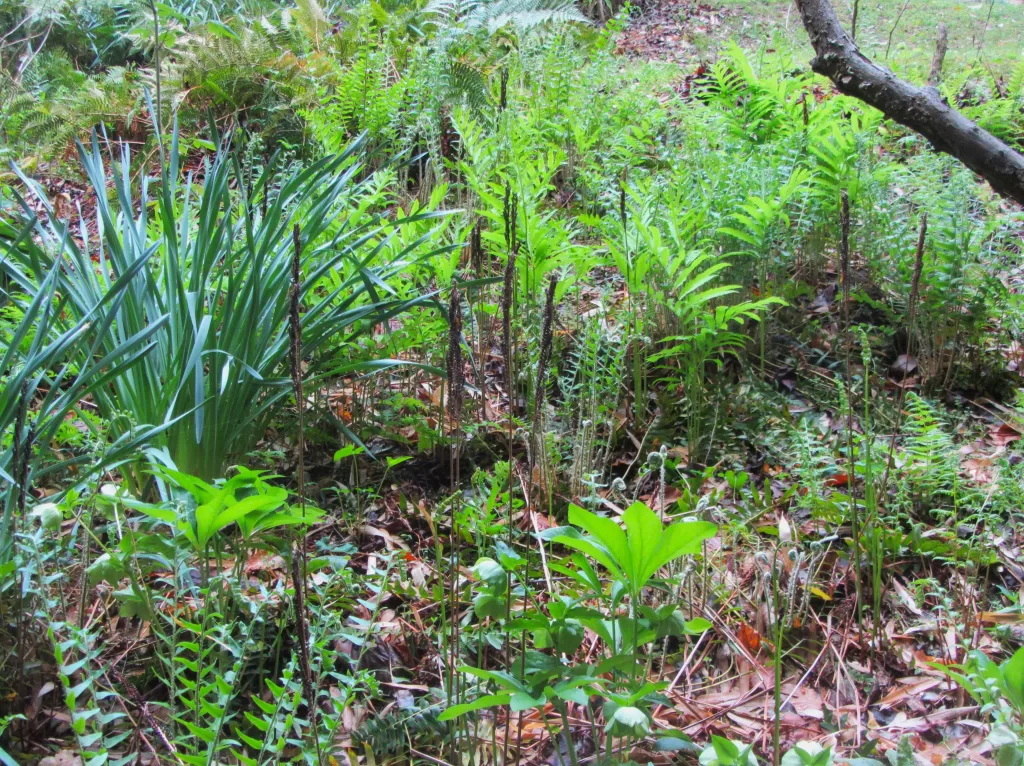
Onoclea sensibilis, in the same genus as ostrich fern, also produces fertile fronds. The fiddleheads of sensitive fern are NOT edible. April 2023, in the author’s fern garden.
Some foragers, particularly those based in the Pacific Northwest of the United States, also harvest lady fern fiddleheads, Athyrium filix-femina (now A. asplenioides). While these ferns aren’t poisonous, they also inhibit thiamine uptake, like bracken fern, and may cause stomach upset. If you decide to try them, take care to identify them correctly, clean and soak them, and then cook them well.
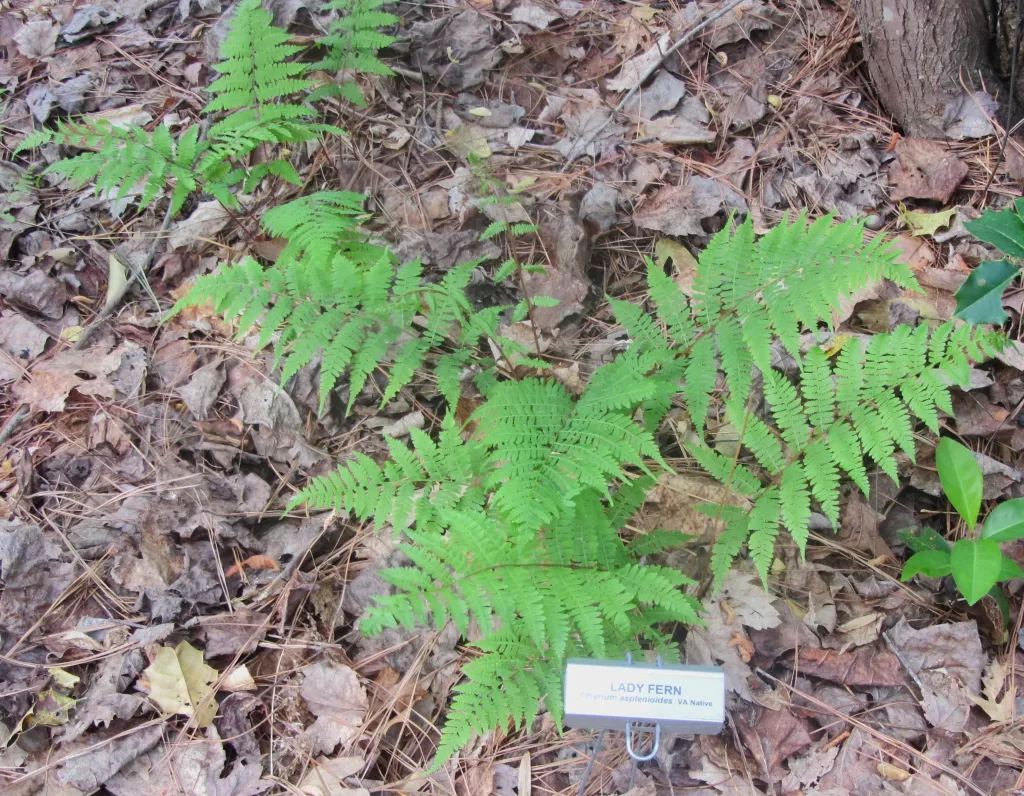
Athyrium, native lady fern is not poisonous, but is not considered good to eat. The WBG-FPA in April 2022.
Take Care if You Dare to Forage for Fiddleheads….
So, if you are walking in the woods this spring, wondering what is tasty and what is not, have a field guide with you to help positively identify wild foods before you sample them. There are quite a few edible and tasty wild foods which emerge in the spring, but we must be careful to correctly identify them, and then to clean and prepare them carefully, before we feast on their wild deliciousness. And of course, as with any new food, try only a small amount at first to see how you react to it before enjoying a large serving or sharing it with others.
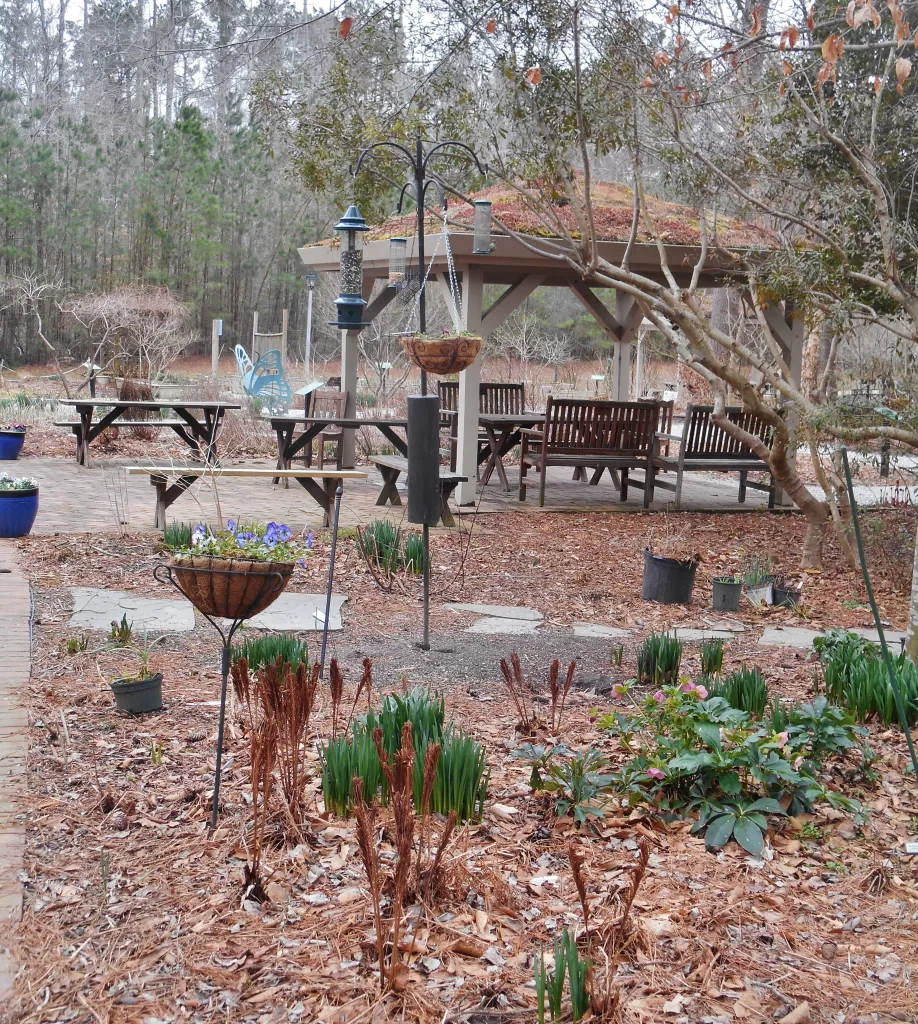
Fertile fronds of ostrich fern mark where fiddleheads will soon emerge as the season warms, in the WBG Shade Garden, in early March, 2019.
All photos by E. L. McCoy
This article was also published in The Hardy Fern Foundation Quarterly Spring 2024 pg. 32-38.
For More Information:
Bradley, David. Ptaquiloside – the Poison in Bracken. The University of Bristol Chemistry Department: Molecule of the Month. Accessed February 2024. https://www.chm.bris.ac.uk/motm/ptq/ptq.htm
El-Begearmi, Dr. Mahmoud. Bulletin #4198 Facts on Fiddleheads. University of Maine Cooperative Extension Publications. Accessed February 2024. https://extension.umaine.edu/publications/4198e/
Luczaj, Lukasz. Edible Ferns of the World: ethnobotany, foraging and cooking. Self-published on Amazon. 2022.
Olsen, Sue. Encyclopedia of Garden Ferns. Timber Press. 2007.
Steffen, Richie and Sue Olsen. The Plant Lover’s Guide to Ferns. Timber Press. 2015.
Thayer, Samuel. The Forager’s Harvest: A Guide to Identifying, Harvesting, and Preparing Edible Wild Plants. Foragers Harvest Press. 2020.
Fiddleheads. The University of Oregon. Accessed February 2024. https://pages.uoregon.edu/ecostudy/elp/ntfp/Fiddleheads%20Final.htm
On the Edibility of Fiddleheads. The Elizabeth C. Miller Library at the University of Washington. Accessed February 2024. https://depts.washington.edu/hortlib/pal/on-the-edibility-of-fiddleheads/

